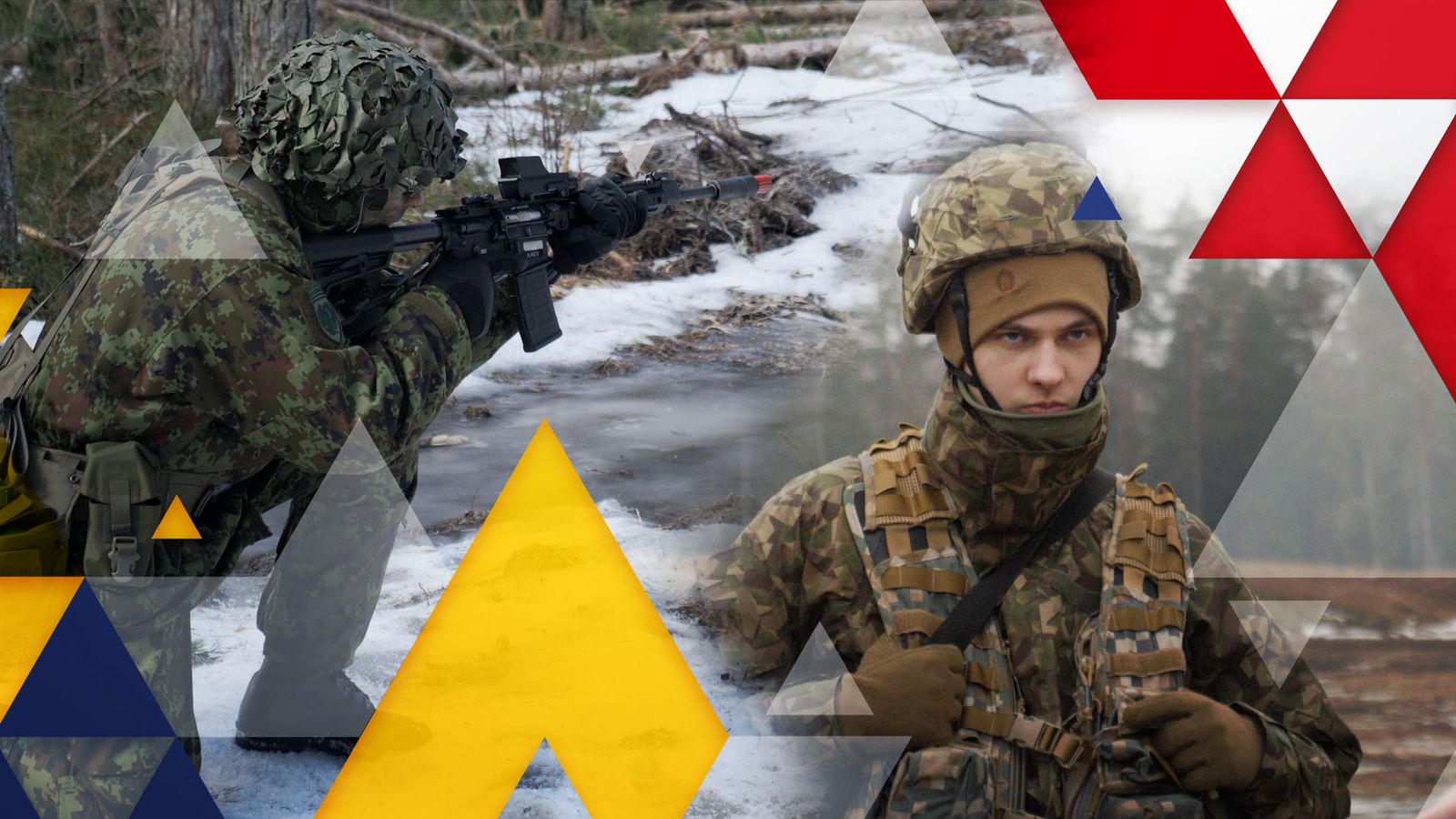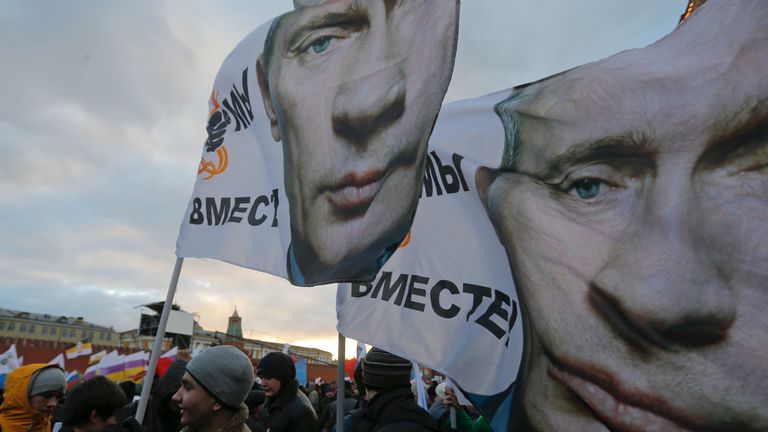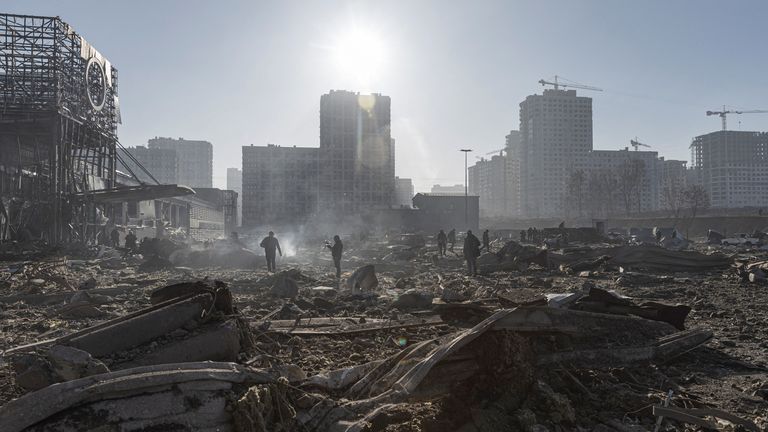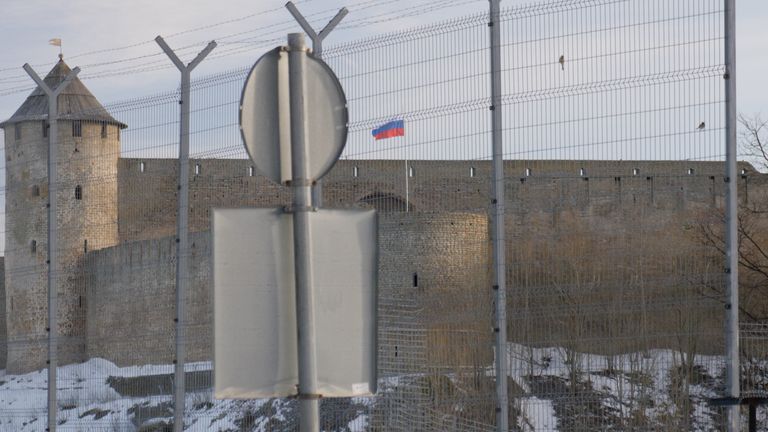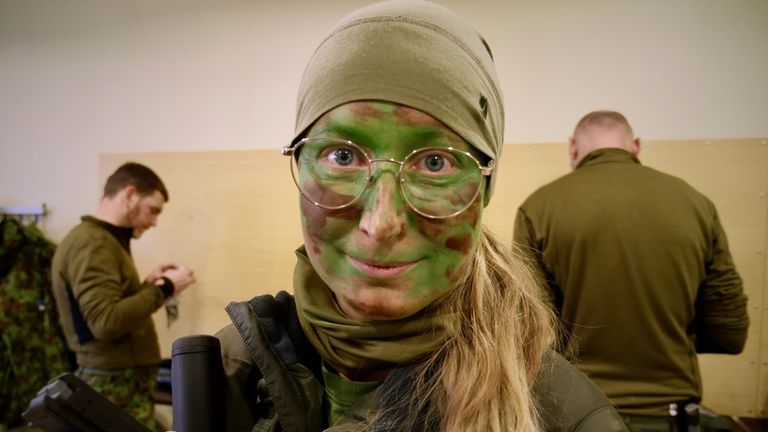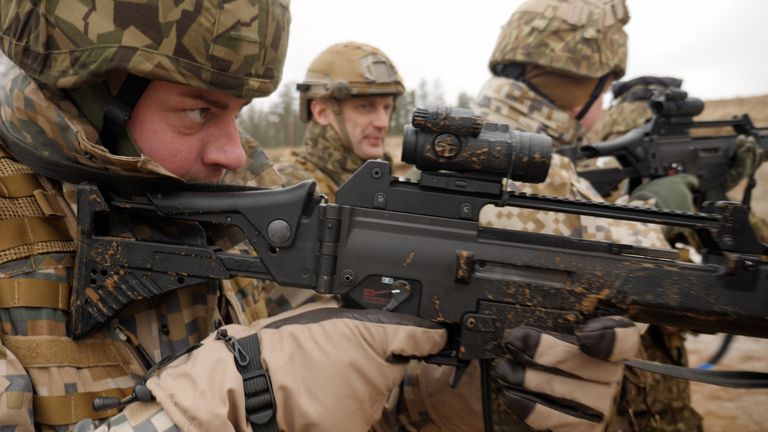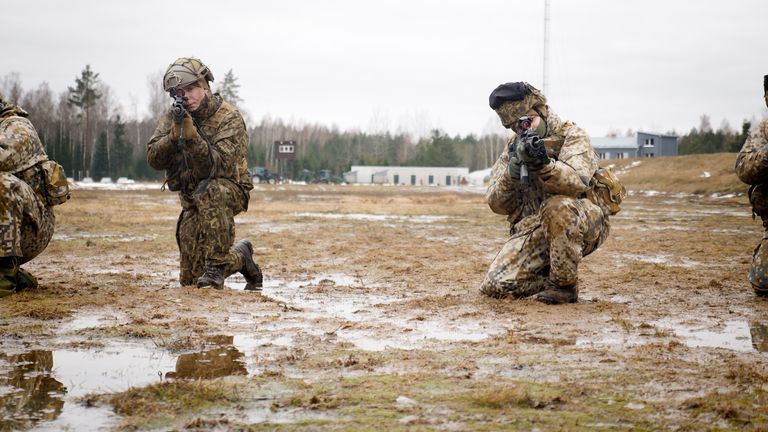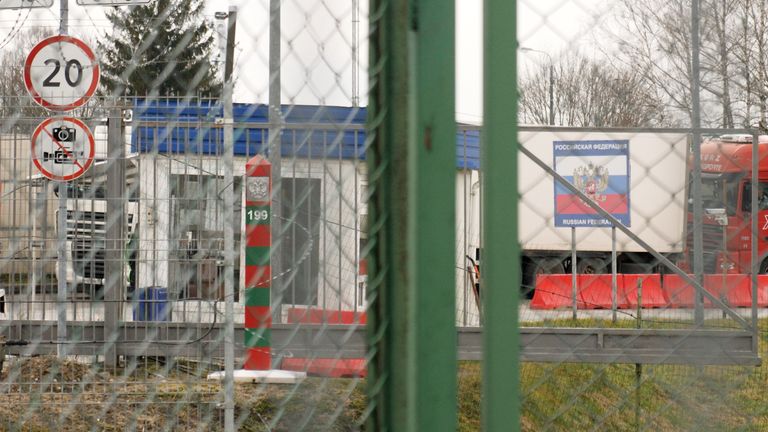The Baltic states have an urgent message for the UK and other NATO allies about the threat posed by Russia: “Wake up! It won’t stop in Ukraine.”
Estonia, Latvia and Lithuania are teaching more of their citizens how to fight and have even announced plans to build a defensive line, including bunkers, along hundreds of miles of border that separates their territories from their much larger neighbour.
Now, as concern grows within NATO about the potential for large-scale conflict returning to Europe, Sky News has travelled from northeast Estonia to southwest Lithuania to hear from soldiers, civilians and politicians who are preparing for a war they hope never to fight.
As former members of the Soviet Union, the Baltics have been sounding the alarm about the existential menace posed by Moscow ever since they joined the NATO alliance two decades ago.
Back then, though, no one really listened.
Instead, the UK and other allies were focused on the conflicts in Iraq and Afghanistan – countering insurgents and Islamist militants is a very different type of fight than a conventional war against a peer enemy like Russia.
Adding to a collective erosion in NATO’s defences, many European states, including Britain, significantly reduced stockpiles of Cold War-era weapons, such as tanks, artillery and ammunition, following the collapse of the Soviet Union, mistakenly believing they no longer needed to be ready to fight a war of survival at a moment’s notice.
Russia’s earlier invasion of Ukraine in 2014, with the capture of Crimea and seizure of swathes of the Donbas, started to change that calculation – but only very slowly.
The concept of ‘deterrence by denial’
The alliance agreed to bolster its defences along the eastern flank of the Baltic states and Poland, with the deployment in 2017 of units of allied troops to all four countries – around 800 soldiers to each nation.
But this was done relatively cautiously – to minimise the risk of triggering an escalation of tensions directly between Moscow and the West as plenty of NATO states, including France and Germany, still had relatively close ties with Russia and did a lot of business.
As a result, the limited mission was not designed to prevent an invasion, but rather to provide a “tripwire” should Russian forces attack that would trigger a much larger allied response to then push them back out.
However, Vladimir Putin’s full-scale war in Ukraine on 24 February 2022 fundamentally altered that thinking too.
The allies realised once Russian troops had entered a country it would take a lot more effort to eject them, so they agreed to beef up their eastern defences even more and expanded them into four other nations.
The aim today is to prevent Russia from ever trying to invade – a concept known as “deterrence by denial”.
Throughout this evolution, the loudest voices inside NATO – urging allies to go further, faster and raising the alarm about Russia’s intentions – have been Estonia, Latvia and Lithuania.
They have also been amongst the strongest supporters of Ukraine and have warned that if Moscow prevails over Kyiv, it will likely try to test NATO’s defences next.
A potential soft spot for any Russian attack
The city of Narva lies on Estonia’s northeastern tip – right next door to Russia.
A vast, medieval castle, with large, stone walls and an Estonian flag fluttering high, stands at one edge of the city, next to a river that marks the border.
On the opposite bank is a second, similarly grand, historic castle, but it flies a Russian flag.
A crossing point, called the Friendship Bridge, connects Narva with the Russian city of Ivangorod.
It is only open to pedestrians after the Russian authorities closed their end to vehicle traffic for construction work at the start of February.
Arnold Vaino, a police officer with the Estonian border guard, walked us on to the bridge, stopping just short of a red post that marks the halfway point and the start of Russia.
He recalled how he felt on the day the Kremlin launched its all-out invasion of Ukraine.
“Nobody feels comfortable when you hear that war has started,” he said. “But [we don’t feel] scared, for sure. But you open your eyes more wide.”
In an indication of the complexities of the geography and history of the region, the majority of residents in Narva speak Russian and some are sympathetic to Moscow.
It makes the city a potential soft spot for any Russian attack under the guise of coming to the aide of the Russian nationals who live in Narva.
Read more:
A day of rage in Kyiv on war anniversary
Where will Russia target next?
Mourners defy Kremlin at Navalny funeral
Any such move, though, would trigger an allied response under one of the founding principles of NATO – an attack on one is an attack on all.
There is no sense of fondness for the Russian government in most other parts of Estonia, including an island of about 9,000 people off the country’s western coast.
NATO commanders believe that Hiiumaa island could be another potential target for Moscow in any war with the West because of its strategic location in the Baltic Sea.
If Russian troops were to seize the territory, they would potentially have the ability to block access to the sea and isolate the Baltic states.
Such a prospect is one that the islanders are doing all they can to deter.
Estonian volunteers urge British civilians to learn to fight
We met a unit of citizen soldiers, faces painted army green, as they practised ambushes with rifles in the forest.
The volunteers – many of them middle-aged dads and the odd mum – are dubbed “the SAS” because they train on Saturdays and Sundays.
They said British civilians should also consider getting off their sofas and learning how to fight.
“It’s wrong to think that somebody else is coming to fight your war if you are not ready to defend yourself,” said Major Tanel Kapper, who commands the Estonian Defence League forces on the island.
Estonian military chiefs have doubled the size of their territorial defence force – the people who would support the much smaller professional army in a crisis – to 20,000 personnel after what Russia did in Ukraine two years ago.
That number comprises about 10,000 Defence League volunteers and the new addition of some 10,000 former conscript soldiers who are part of the military reserve.
‘We will kill as many of you as possible’
Polishing part of a rifle back at his base, a volunteer called Taavi, a father of two, said he decided to join the Defence League on Hiiumaa island along with about 14 friends last year in part as a response to the Ukraine war.
The construction worker said he did not want conflict, but was ready for combat if Russia invades.
“I have to take the weapon and try to protect my family, my home,” he said.
Major Kapper had a warning for Moscow: “It will be a bloody mess if you come here. We will definitely kill as many of you as possible.”
As for whether he had a message to other NATO countries like the UK that maybe are not doing as much to bolster their defences, the officer said: “To wake up. It won’t stop in Ukraine. If we don’t stop them, then they will come further and further.”
Latvia bulking up its military due to Russia threat
There is a similar sense of urgency in next door Latvia, which reintroduced conscription last year after becoming the only Baltic state to halt mandatory military service in 2006.
The country plans to double the size of its armed forces – professionals and reserves – to 61,000 by 2032.
“War [in Ukraine] is already happening, so it’s not a question: is Russia going to be aggressive? It already is aggressive,” said Krisjanis Karins, the Latvian foreign minister.
“The point of the draft is to beef up capable and equipped and trained reservists,” he told Sky News in an interview on the sidelines of a major security conference in Munich in February.
“It’s not replacing the professional army, it’s augmenting the professional army.”
Asked whether it would make a difference if the UK instated conscription, Mr Karins, a former prime minister, said: “I think it would make a difference if any European country and of course the larger countries, it would make a bigger difference.”
Sky News was invited to visit a training base in southeast Latvia, close to its border with Belarus, a close Russian ally, where a mix of conscripts and other recruits were going through a three-week basic training course with the National Guard.
‘Every man needs to at least try military life’
The National Guard is a branch of the armed forces that is made up of volunteers. At a time of war, they would offer support to the professional military.
“Bam! Bam! Bam!” the recruits shouted, rifles raised, mimicking the sound of gunshots, as they practised a response to an ambush on a muddy shooting range surrounded by forest.
Eduard, 18, was one of seven conscripts among the group of about 20 on the range. All seven were voluntary conscripts, rather than being ordered to serve.
“I think that every man in the world needs to at least try military life,” said Eduard.
A Latvian general explained how conscription is about much more than simply generating fresh boots on the ground – it is also about growing a sense of national service and a desire for each citizen to do their bit to help protect the country.
“Everyone has the right to serve – an obligation to serve – the nation,” said Major General Andis Dilans, the chief of the joint staff of the National Armed Forces, Latvia’s second most senior commander.
“This is really the cornerstone of democracy,” he said in an interview in the capital Riga.
“Therefore, we looked at this not just as a war-fighting force of the conscription, but looking at the connection between the public and the military in case of crisis, in case of war.”
How Lithuania borders a potential flashpoint
The final leg of our journey took us to the southwestern edge of Lithuania, which borders a heavily fortified Russian exclave called Kaliningrad.
The Russian territory also shares a border with Poland, another NATO state.
It means the only way for vehicles, such as lorries loaded with goods, coaches carrying passengers, or ordinary cars to travel between the exclave and mainland Russia is by transiting through Lithuania and into Belarus.
The crossing was calm when we visited, with a long queue of lorries on the Russian side, waiting to be allowed into Lithuania.
Click to subscribe to the Sky News Daily wherever you get your podcasts
A border guard said the number of vehicles – about 300 per day in total, moving in and out – had roughly halved since 2022 because Western sanctions had limited the types of goods that are permitted to be transited through Lithuania.
Communication between the guards on either side of a long wire, fence, topped in sections with barbed wire and bristling with cameras, had also been all but severed.
In the past, officials, who might have been stationed at the crossing point for two or three decades, would often speak with their Russian counterparts but that has stopped completely.
A mobile phone line still exists that can be called in an emergency, but the guard said that the Russian side does not tend to pick up.
Another potential flashpoint is a nearby strip of land, about 60 miles long, that connects Kaliningrad with Belarus and is bordered by Lithuania and Poland.
It is called the Suwalki Gap.
The concern among NATO commanders is that if Russia were to capture the corridor, it would provide another way to cut off access to the Baltic states.
Gitanas Nauseda, Lithuania’s president, summed up the response to the threat next door.
“All Baltic countries, Poland and other countries of the eastern flank of the NATO do a lot in order to utilise all the possibilities of [the] collective defence system, called NATO,” he said in an interview.
“But we also do a lot individually by increasing our defence spending, by closely cooperating with our neighbours and my country is especially active in this field.”
It is why a growing number of citizens in Estonia, Latvia and Lithuania are volunteering to serve.
But their ability to deter Russia may depend on whether the citizens of other allies follow suit.
